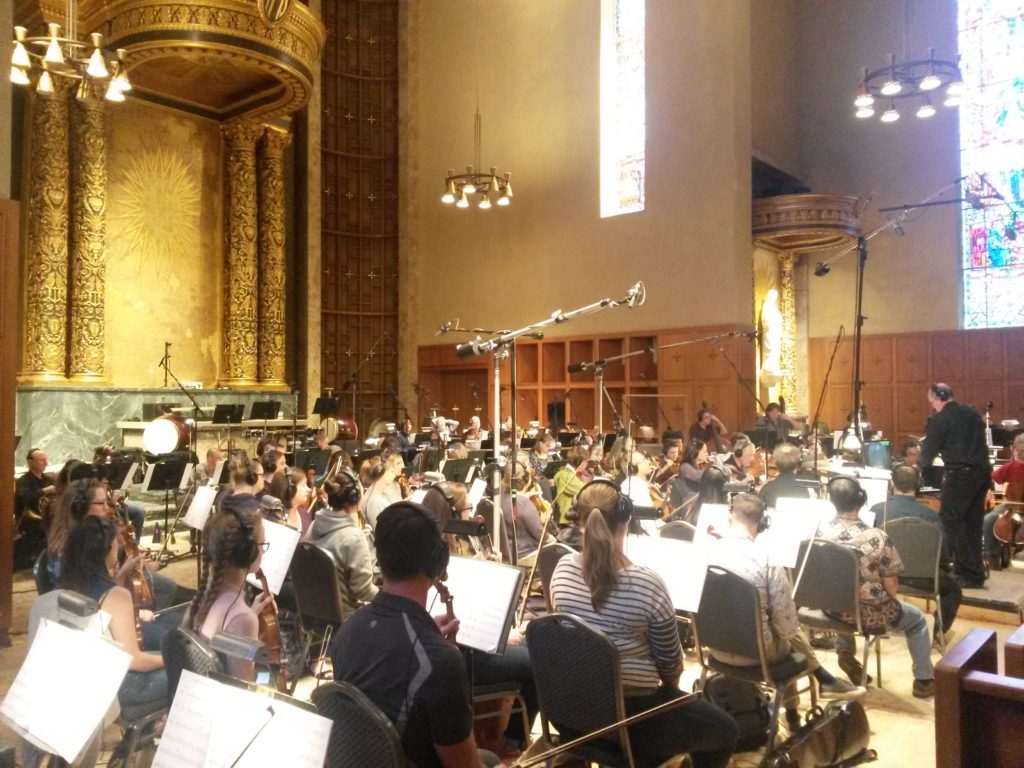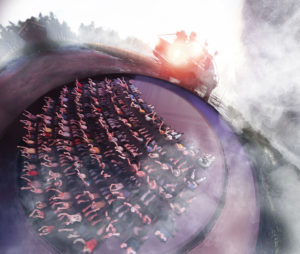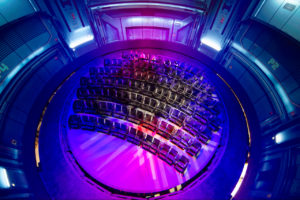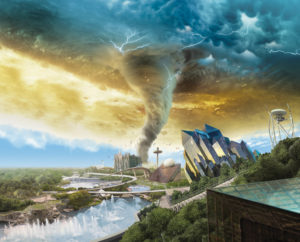By Arthur Levine | Funworld
The importance of music and sound in storytelling at attractions
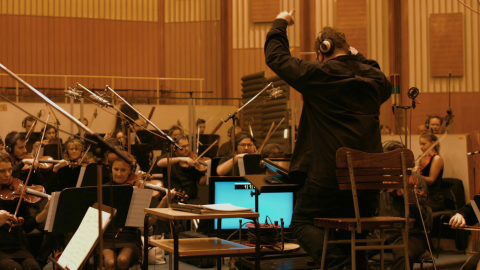
It’s been said that music soothes the savage beast. But it can also be used to heighten the terror that visitors experience when they encounter a savage beast at an attraction.
Just ask Nick Hutson. The U.K.-based composer wrote and produced an entirely new audio soundtrack for the 2018 edition of “Fright Nights” at Thorpe Park in Surrey, England. It was his judicious use of creepy chants, freaky ambient noises, and off-putting, minor-chord riffs on the park’s theme song that helped keep visitors on edge and engaged in the annual Halloween event.
Whatever the desired response, music and sound can be essential elements in evoking feeling. The record 14 inversions that “The Smiler” at Alton Towers in Staffordshire, England, delivers are enough to make anyone a little loopy. But Ben Dowson, who was the creative lead of Resort Theme Parks for Merlin Entertainments when the coaster was being developed, really wanted to play head games with the riders aboard the diabolical attraction he helped design. That’s why he enlisted IMAscore, a German-based music and audio production company.
Dowson and his team “had a crazy theming idea about a machine that makes people happy, but in a creepy way,” explains Xaver Willebrand, IMAscore’s managing director and one of its co-founders. By working closely with the ride designers, the shop was able to
develop a sinister sounding and purposely annoying score that plays on people’s emotions and supports “The Smiler’s” diabolical storyline.
The music can’t be that annoying, however. According to Willebrand, the tune has generated loads of buzz, including nearly a million views on YouTube. It’s those kind of results that have made IMAscore one of the industry’s market leaders. Its team of seven composers has worked on dozens of projects for attractions, including Phantasialand. The German park has been selling so many CDs of its rides’ music, Willebrand says Phantasialand has more than recouped the fee it paid the shop to produce the soundtracks.
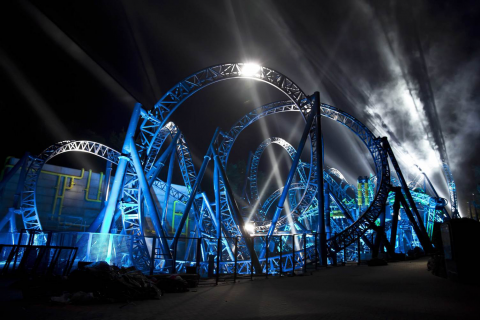
More often than not, the music that IMAscore composes for parks is used to promote attractions and help establish their themes. For example, the production house developed a suitably grand-scale theme song for “The Oath of Kärnan,” a 240-foot-tall beast of a coaster at Germany’s Hansa Park. Its soundtrack features a live 63-piece orchestra and a 40-member choir. Along with a logo and other visual elements, an attraction’s music informs its identity. It is also typically used to launch a ride’s marketing campaign and generate anticipation prior to opening. The music is then incorporated into an attraction’s queue and loading station to help set the tone for the experience.
Occasionally, IMAscore works on projects for rides that are equipped with onboard audio, and its music accompanies and enhances the actual attraction. Such was the case with “Highlander,” which opened this year at Hansa Park. Willebrand says that the composers used an animated video rendering of the ride and scored it like a movie soundtrack. Not that the world’s tallest Gyroddrop tower—which includes tilting seats no less—needed it, but IMAscore designed the music to make riders even more anxious as they brace themselves for the 120-meter drop.
Even small parks, Willebrand says, want to incorporate music because they “appreciate the power of audio.” For example, Germany’s Schwaben Park enlisted IMAscore to develop the music for “Wilde Hilde,” a coaster that opened in 2018. Working with the ride’s chicken theme (which is apparently about a wild fowl named Hilde), the composers thought outside the henhouse.
“We developed a special soundtrack using a chicken,” Willebrand says while trying to keep a straight face. The IMAscore team recorded and digitized the animal’s clucks, cheeps, and cackles so that they could play the sounds using a MIDI keyboard. “It’s the craziest thing we’ve ever done,” he adds with a laugh.
An attraction could boast the most sophisticated ride system and compelling visuals, but without the right soundtrack tying everything together, it can all fall apart. When music and sound are in harmony with other sensory components, attractions can truly take flight.
Disney’s “Soarin’” inspired Kyle Griffith, the owner of Miner’s Landing at Pier 57 in Seattle, Washington, to create his own flying theater attraction, “Wings Over Washington.” Envisioned as a love letter to his beloved state, the diehard Disney fan (How diehard? He named his son Walter.) wanted to have a similarly sweeping orchestral score underpinning the E-ticket ride.
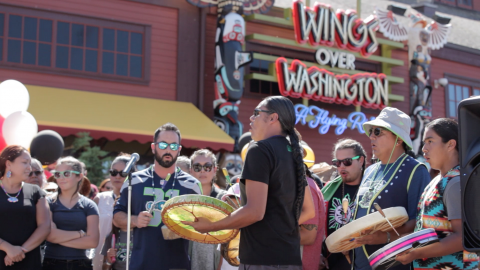
“Music helps convey a sense of adventure and wonder,” Griffith says. “It makes the ride experience feel more grand and awe inspiring.”
To help him realize his vision, Griffith enlisted Dynamic Attractions and Super 78. Brent Young, the founder and president of Super 78, led the creative team and directed the film for “Wings Over Washington,” which opened in 2017.
A musician himself, Young recognizes the critical role music plays and laments that it may not always get the credit it deserves. “It’s a little ethereal and has a magical quality,” he says. Since attractions typically only last a few minutes, music is a great form of shorthand to quickly establish a tone and make a powerful impact. “It’s among the codes and patterns we use to tell stories,” Young adds.
Dynamic Attractions designs and builds the hardware for rides such as “Wings.” According to Cindy Emerick Whitson, a senior vice president at the company and a member of the project’s creative team, music can provide a portal to audiences’ hearts and souls. “It appeals to our emotions,” she says. “Music can take audiences away from reality and immerse them in an attraction.”
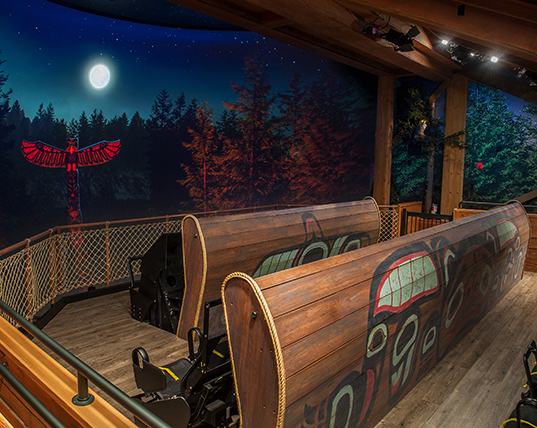
Young brought in the sound production company, Yessian, to develop the music and oversee the sound design. As he was conducting research for the project, Brian Yessian, the shop’s partner and CCO, says that his guiding principle was to discover “the sound of the state of Washington.” One of his finds was The Sacred Water Canoe Family, a Native American vocal and percussion group. A production crew recorded a performance by the ensemble. Representing the state’s indigenous people, the music is featured in the queue, the preshow, and in the dramatic opening moments of the main theater show.
While hunting online, Young found a piece of music that Antonio Di Iorio had composed for the Olympics. It moved him and had the kind of epic, symphonic feel that he wanted to bring to the attraction. It must have been kismet, because Young learned that the Italian musician had studied abroad in the United States and attended college in Seattle. He recruited the composer for the project.
As Young filmed scenes such as gliding above Puget Sound, encountering Snoqualmie Falls, and flying over Mount St. Helens, he’d
share footage with the creative team for inspiration. Di Iorio composed a number of musical snippets and tweaked them, incorporating feedback from his colleagues, until the music evolved into what now plays in the attraction. Fittingly, the score is called “Spirit of Washington.”
The music, which is performed by the Northwest Sinfonia Orchestra, became a character in its own right, according to Young. In addition to orchestral and Native American music, the score includes some bluegrass, which delivers hints of Western pioneer culture. Young contends the soundtrack is the connective tissue that pulls audiences through the experience.
The music exudes “triumphant energy and a splash of Pacific Northwest mysticism,” adds Emerick Whitson.
Describing the attraction as “audio immersive,” Yessian says that, beyond the music, sound design was an important part of the project. When passengers fly over the Olympic National Forest, they hear branches and leaves whipping past them, for example. They also hear the nuanced crunches of mountain bikers’ tires as they spin across gravel. “We keyed into little details that really bring the film to life,” says Yessian.
Music may help bring the attraction to life. But a musical soundtrack almost never accompanies actual life. It’s one of the peculiarities of themed entertainment (along with movies, television, and other media): There is typically no justification for music in an attraction; but, without music, an attraction somehow seems less “real.”
That’s why Hutson likes to put diegetic moments—music and sounds characters can hear and naturally belong in scenes—in his soundscapes. For example, he created a new version of the WWTP radio station broadcast that is played over the loudspeakers in Amity Cove, Thorpe Park’s land themed to an early-1960s New England town. “I built a real world of sound instead of just random horror music,” Hutson says.
To reinforce the “Fright Nights” conceit that an evil cult took over the town, the composer interspersed period songs and jingles with the patter of a demonic DJ. He had a U.S.-based voice actor record the role and had him adopt the upbeat cadence of an AM radio DJ who incongruously talked about death, murder, and destruction.
Hutson produced a total of 17 tracks that were used throughout the park, including the entrance gate, some of the mazes, and some rides. For the “Colossus” coaster, his assignment was to develop something “celestial.” The music incorporated half tones that gave it an Eastern flavor, he says. For the “Stealth” coaster’s launch, Hutson messed with passengers’ minds. Instead of the ride’s predictable countdown, he made it sound as if the audio track slowed down and ground to a halt. The trains then launched without any cue.
Because he’d done work for Merlin Entertainments and other attractions, Thorpe Park trusted Hutson and gave him plenty of latitude. He had one on-site meeting to identify what was needed. “Then they let me get on with it, which was great,” Hutson says. To keep the park in the loop, he would place his tracks in a shared file as he developed and updated them.
A virtual one-person shop, Hutson composes, performs, and records music, and provides parks with finished pieces. With a background in musical theater, he can also write scripts when necessary. Hutson, who hosts “Nick’s ERT” on The Season Pass Podcast, is a big fan of parks and brings passion to his projects. “I’m lucky to blend what I love with what I do for work,” he says.
Griffith loves attractions also and is thrilled to have created his own in Seattle. “We created a ‘wow’ experience—which also happens to be the ‘Wings Over Washington’ acronym,” he notes. “And music is a big part of it.”
source: http://bit.ly/2JNcPeU
via: Funworld

